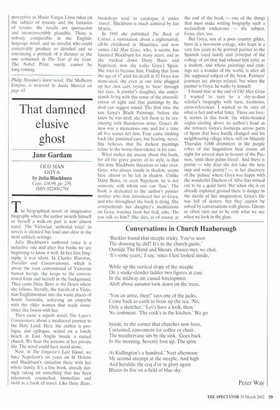That damned elusive ghost
Jane Gardam
OLD MAN GOYA by Julia Blackburn Cape, £16.99, pp. 239, ISBN 0224062794 The biographical novel, or imaginative biography where the author awards himself or herself a walk-on part is now almost usual. The Victorian 'authorial voice' in novels is silenced but loud and clear in the most unlikely settings.
Julia Blackburn's authorial voice is a seductive one and after five books we are beginning to know it well. In her first biography it was silent. In Charles Waterton, Traveller and Conservationist, which is about the least conventional of Victorian human beings, she keeps to the conventional form and herself in the background. Then came Daisy Bates in the Desert where she follows, literally, the travels of a Victorian Englishwoman into the waste places of South Australia, achieving an empathy with the older woman that reads sometimes like fusion with her.
Then came a superb novel, The Leper's Companions, about a mediaeval journey to the Holy Land. Here the author is prologue and epilogue, seated on a lonely beach in East Anglia beside a ruined church. We hear the sorrows of her private life. The novel could have stood alone.
Next, in The Emperor's Last Island, we have Napoleon's six years on St Helena and Blackburn's visitation there with her whole family. It's a fine book, already daringly taking on something that has been extensively researched, immediate and vivid as a book of travel. Like Daisy Bates, bookshops tend to catalogue it under 'travel'. Blackburn is much admired by Jan Morris.
In 1995 she published The Book of Colour, a rumination about a nightmarish, elf-lit childhood in Mauritius, and now comes Old Man Goya, who, it seems, has haunted Blackburn for many years, and as she tracked down Daisy Bates and Napoleon, now she walks Goya's Spain. She tries to become him. Finding that from the age of 47 until his death at 82 Goya was stone-deaf, she even at one time plugged up her own cars, trying to 'hear' through her eyes. A painter's daughter, she understands living with this sense of the intensification of sight and that paintings by the deaf can suggest sound. The first time she saw Goya's Black Paintings, before she knew he was deaf, she felt them to be resonating with thunderous noise. Goya's illness was a mysterious one and for a time all five senses left him. Four came slinking back like punished curs, but hearing, never. She believes that his darkest paintings relate to the worse-than-silence in his ears.
What makes me uneasy about this book, for all the grave poetry of its style, is that this time Blackburn threatens to take over. Goya, who always stands in shadow, seems here almost to be left in shadow. Unlike Daisy Bates, or even Napoleon, he is not someone with whom one can 'fuse'. The book is dedicated to the author's painter mother who first introduced her to Goya, and who throughout the book is dying. She comprehends her daughter's meditations on Goya, watches from her bed, asks, 'Do you talk to him?' She dies, as of course at the end of the book — one of the things that must make writing biography such a melancholy endeavour — the subject, Goya, dies, too.
But Goya, son of a poor country gilder, born in a two-room cottage, who leapt in a very few years to be portrait painter to the Spanish royal family and principal of the college of art that had refused him entry as a student, and whose paintings and etchings are a wonder of the world, is after all the supposed subject of the book. Painters' journeys are always related, but when the painter is Goya, he walks by himself.
I found that at the end of Old Man Goya I wanted to turn to a dry-as-dust scholar's biography with facts, footnotes, cross-references. I wanted to be sure of what is fact and what fancy. There are lovely scenes in this book: the white-headed eagles circling above its author's head as she retraces Goya's footsteps across parts of Spain that have hardly changed and his neighbouring village where still on Maundy Thursday 5,000 drummers in the purple robes of the Inquisition beat drums all night for several days in honour of the Passion, 'until their palms bleed'. And there is poetry — why does she not take the next step and write poetry? — in her discovery of the 'palace' where Goya was happy with the wonderful Duchess of Alba that turned out to be a quiet farm. But when she is on already explored ground there is danger in the dazzle of her imagination. Goya's life was full of secrets, but they cannot be solved by conversations with ghosts. Ghosts so often turn out to be only what we see when we look in the glass.


































































 Previous page
Previous page